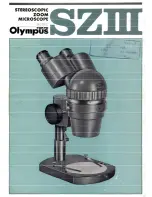
STEINDORFF
®
Biological Microscope
NYMCS-237
Instruction Manual
This manual is written for biological microscope NYMCS-237 series. To ensure the safety, obtain
optimum performance and to familiarize you fully with the use of this microscope, it is recommended
strongly that you study this manual thoroughly before using the microscope and retain this manual in an
easily accessible place near the work desk for future reference.


































